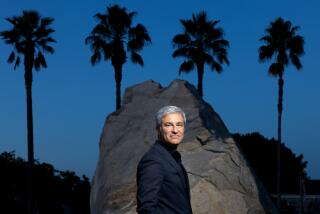LACMA to show Chris Burden’s last finished work, ‘Ode to Santos Dumont’
- Share via
In early January, artist Chris Burden gathered a small group of friends and colleagues in an airplane hangar in Camarillo to witness his newest sculptural installation, “Ode to Santos Dumont,” take flight.
It was a beautiful, clear afternoon, and as shards of sunlight shot through the space, the 40-foot-long white balloon floated ethereally around the room. Burden stared up at it, clearly proud of the fusion of science, engineering and art, said Paul Schimmel, a close friend who was there.
“He was kind of loving that magic space between him as a kind of engineer and him as a kind of intuitive visionary,” said Schimmel, formerly chief curator at the Museum of Contemporary Art. “It had this kind of intimacy to it, this beautiful, slow propeller whirring. It flew at a human pace, almost like walking — it was elegant and poetic.”
The piece would be Burden’s last finished artwork. The 69-year-old conceptual artist died Sunday at his home in Topanga Canyon.
“I took a little video that day, during the test flight, and Chris said, ‘Don’t show it to anyone or post to Facebook!’” Schimmel said. Despite the bravado often involved in his performance art, Burden was famously private in his personal life. His diagnosis of malignant melanoma was kept secret from all but a tight circle of friends and family members.
A wider audience will be able to see “Ode to Santos Dumont” in flight at the Los Angeles County Museum of Art for a month beginning Monday.
Burden’s gallerist Larry Gagosian calls it “Chris’ personal spaceship.” It’s a homage to the Brazilian aviator Alberto Santos-Dumont, who flew the first practical dirigible around the Eiffel Tower in 1901.
A work in the spirit of Burden’s kinetic sculpture “Metropolis II,” also at LACMA, the eye-shaped polyurethane balloon, which has a fiberglass propeller and an aluminum gondola made from custom Erector set parts, is as much a timed performance as it is a sculpture.
Powered by helium and a small gasoline motor, it will whir through the back of the museum’s Resnick Pavilion for 15-minute flights, at
intervals throughout the day.
LACMA Director Michael Govan calls the work “stunningly beautiful and also ethereal. It was a thrill to see this airship fly.”
Govan said he’d had several discussions with Burden about “Ode to Santos Dumont” over the past four years — the two shared an interest in aviation.
When Burden called Govan several weeks ago to tell him the artwork was finished, the two discussed showing it in a monthlong pop-up exhibition at the Resnick.
“I had no clue he was as ill as he was. I assumed he’d be around for a long time,” Govan said. “Did he race to show the piece because he was sick? I don’t know, maybe. But the issue about showing the piece now, for us, was because we had the space at the Resnick — it flies around in 60-foot circles, and that’s exactly the space we have — and I was just excited to show it.”
Burden worked on “Ode to Santos Dumont” at his studio in Topanga for about a decade, commissioning the handmade engine — a replica of a 1903 gasoline motor — from craftsman and inventor John Biggs. The two worked on it for seven years until all the kinks were smoothed out.
Burden began focusing on finishing the work after his 2013 survey show “Chris Burden: Extreme Measures” opened at New York’s New Museum, Schimmel said.
“That’s when he started bringing all the elements together,” Schimmel said. “But Chris has had a long interest in flight — he made ‘The Flying Kayak’ [in 1982], he made what he called the CB Air force, he’s had dirigibles on the top of the Eiffel Tower, which in some ways is the prelude to this particular work.”
Shortly before he died, Schimmel said, Burden was working on plans for what he called “Xanadu,” reinstalling some of his monumental sculptural works in a public setting. He hoped to include “What My Dad Gave Me,” a 65-foot-tall skyscraper made of toy parts that debuted at Rockefeller Center in 2008 as well as beehive bunkers from “Extreme Measures.”
Burden created a detailed 3-D model outlining the arrangement of the sculptures in a park-like setting, Schimmel said.
“I believe that model was the last thing Chris was working on before he passed away,” Schimmel said. “He wasn’t well, but he went over to the studio after hours to look at the model — he felt his previous drawings weren’t sufficiently detailed enough.
“He wanted people to be able to realize his vision of bringing these sculptures together under one massive installation.”
In some ways, “Ode to Santos Dumont” is a quintessential example speaking to why Burden spent years, as he did, erecting large-scale, often-complicated installations.
“A lot of what motivates Chris to make these things is so that he can discover for himself what the original inventor felt in the process of making something,” Schimmel said.
“[‘Ode to Santos Dumont’] was enormously satisfying for Chris. He thought it would take a lot more adjustments; and he was so thrilled that he, as an artist, was able to intuit these things that generally an engineer would rely on pure mathematics to figure out.”
Govan considers “Ode” intrinsically Burden.
“There’s a lightness to this work that, by definition, is so moving as an image,” Govan said. “The ode is very much about that aspect of the human spirit — when people say things can’t be done, you persevere. You tinker, you invent, you figure it out. And that’s very much what Chris was about.”
More to Read
The biggest entertainment stories
Get our big stories about Hollywood, film, television, music, arts, culture and more right in your inbox as soon as they publish.
You may occasionally receive promotional content from the Los Angeles Times.











